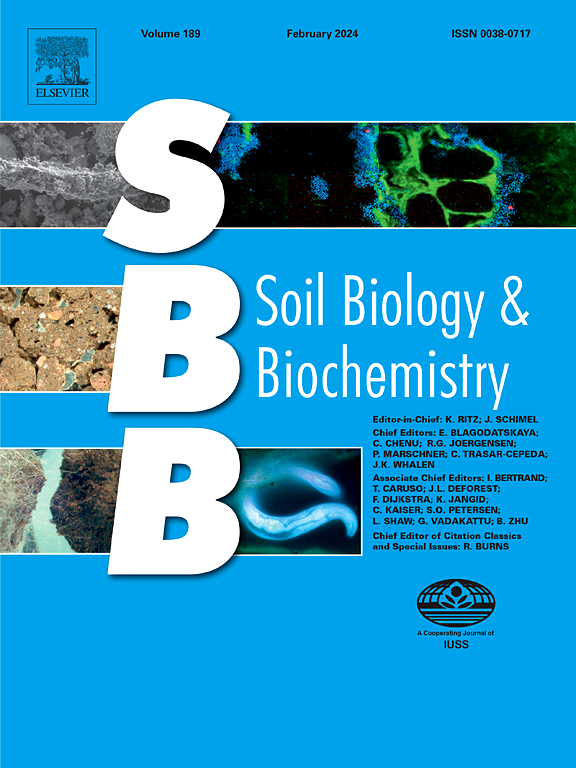线虫的生命策略决定了盐沼100多年初代演替中食物网的能量模式
IF 10.3
1区 农林科学
Q1 SOIL SCIENCE
引用次数: 0
摘要
了解沿演替梯度的线虫群落动态对于预测生态系统对环境变化的响应至关重要。然而,关于线虫群落及其相关食物网沿时间序列的动态研究仍然有限。我们沿着一个完善的盐沼时间序列采样土壤,该序列跨越了一个多世纪的自然演替,并量化了线虫群落。结果表明,线虫总丰度与演替阶段呈曲线关系,在演替中期达到峰值。然而,不同营养和生命策略组的丰度由于对土壤和植物特性的特定响应而对演替表现出不同的响应。早期以菌食动物为主,中期以真菌和草食动物为主。杂食-食肉动物仅在第7年显著增加,其他阶段没有差异,这可能是由于高土壤盐度抑制了自上而下的营养调节。演替阶段对k -战略型线虫的影响大于r-战略型线虫,与网络稳定性密切相关,而r-战略型线虫对提高网络复杂性更为重要。此外,线虫食物网的能量流均匀性(而非能量通量)与演替阶段显著相关。r-策略对能量通量的贡献更大,而k -策略对流动均匀性的贡献更大。这些发现突出了利用线虫作为生物指标预测生态系统稳定性和功能的价值,强调了线虫生命策略在初级演替过程中线虫食物网能量动态变化中的重要作用,并为自然演替过程中生态系统的保护和管理提供了有价值的指导。本文章由计算机程序翻译,如有差异,请以英文原文为准。
Life strategies of nematodes determine energy patterns of food webs over 100 Years of primary succession in a salt marsh chronosequence
Understanding nematode community dynamics along succession gradients is critical for predicting ecosystem responses to environmental changes. However, studies on the dynamics of nematode communities and their associated food webs along chronosequences remain limited. We sampled soils along a well-established salt marsh chronosequence that spans more than a century of natural succession, and quantified nematode communities. The result showed that total nematode abundances exhibited a curved relationship with the stage of succession, peaking at intermediate stages. However, the abundance of different trophic and life strategy groups showed different responses to succession due to their specific responses to soil and plant properties. Bacterivores dominated in the early stage, while fungivores and herbivores dominated in the middle stage. Omnivores-carnivores only showed a significant increase in year-7, with no differences across other stages possibly due to high soil salinity suppressing top-down trophic regulation. K-strategist nematodes were more influenced by the stage of succession than r-strategist, correlating strongly with network stability, while r-strategists were more crucial for enhancing network complexity. Additionally, energy flow uniformity, rather than energy flux, in the nematode food webs was significantly correlated with the stage of succession. r-strategists contributed more to energy flux, whereas K-strategists were more essential for flow uniformity. These findings highlight the value of using nematodes as bioindicators to predict ecosystem stability and functions, emphasize the crucial role of nematode life strategists in shifting energy dynamics within nematode food webs during primary succession, and offer valuable guidance for the conservation and management of ecosystems undergoing natural succession.
求助全文
通过发布文献求助,成功后即可免费获取论文全文。
去求助
来源期刊

Soil Biology & Biochemistry
农林科学-土壤科学
CiteScore
16.90
自引率
9.30%
发文量
312
审稿时长
49 days
期刊介绍:
Soil Biology & Biochemistry publishes original research articles of international significance focusing on biological processes in soil and their applications to soil and environmental quality. Major topics include the ecology and biochemical processes of soil organisms, their effects on the environment, and interactions with plants. The journal also welcomes state-of-the-art reviews and discussions on contemporary research in soil biology and biochemistry.
 求助内容:
求助内容: 应助结果提醒方式:
应助结果提醒方式:


